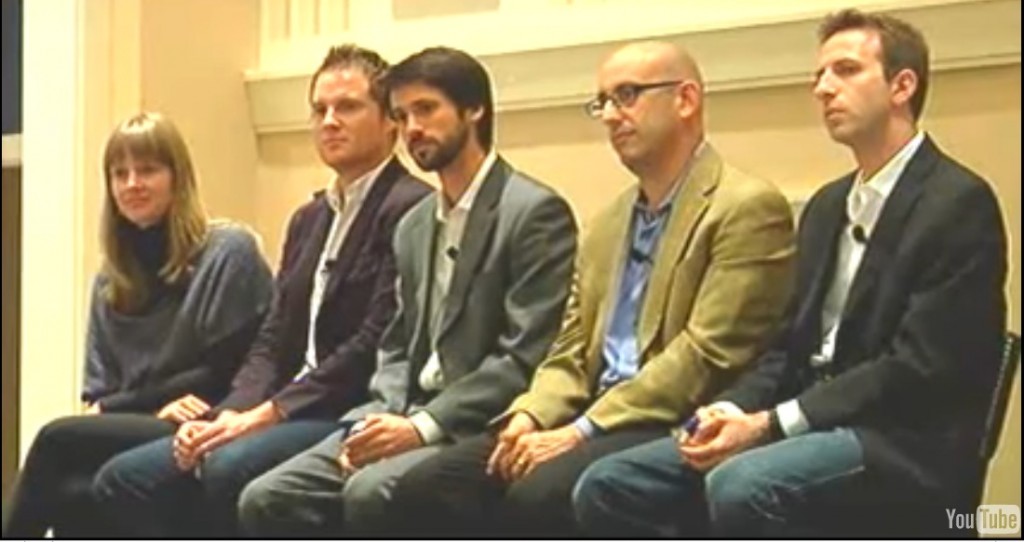Business Model Trends – The Good, The Bad, and The Ugly
March 22, 2011

Kevin Rose of Digg, Bill Gates of Microsoft, and Nathan Myhrvold of Intellectual Ventures at the TED Conference (Photo courtesy of Steve Jurvetson).
Two days before an earthquake measuring 9.0 on the Richter scale struck Japan, resulting in a devastating tsunami and near meltdown at the Fukushima nuclear power plant, we wrote on this blog about “the growing interest in nuclear power” as an alternative to coal fired power plants.
Oops!
While nuclear power-generating facilities have been greatly improved since the Fukushima reactors were built — and the prospects for nuclear energy in the future are still bright — the timing is bad. The prospects for nuclear energy in the short term have dimmed as the costs associated with using that technology are being recalculated.
That wasn’t the only thing wrong with my blog post. A reader called my attention to the case against venture capitalist Nathan Myhrvold’s company, Intellectual Ventures. Myhrvold is the former chief technology officer of Microsoft whose new company invests in technology rather than investing in companies. Intellectual Ventures buys the rights to patents it likes, then markets those patents to other firms. Or does it?
According to Mike Masnick, the prolific and outspoken editor of TechDirt, Myhrvold’s venture is not based on marketing patents but on “shaking down” companies by suing anyone using its patents without permission. Masnick accuses Intellectual Ventures of disguising its true business model by using shell companies to file the lawsuits:
[Intellectual Ventures] had decided to protect its brand name by getting other companies or creating those companies itself, giving the patent to those other companies that no one had ever heard of, and having them sue.
Ouch!
While we did praise Myhrvold’s business plan on this blog, his method for picking technologies to invest in was our focus, not his manner of collecting on those investments. However, without beating up on ourselves too much, we should point out that another company with a strikingly similar business plan has been the recipient of tremendous admiration in the media these past few weeks.
I’m speaking of ARM, the technology company behind the low-heat computer chips used in Apple’s iPhone and iPad, along with many other smartphones and tablets. The company is not bashful about its creative structure:
ARM has an innovative business model. Instead of bearing the costs associated with manufacturing, we license our technology to a network of partners, mainly leading semiconductor manufacturers and OEMs. These partners utilise our designs to create smart, low energy chips suitable for modern electronic devices.
This structure — licensing technology rather than manufacturing it — has led to a gross margin for ARM of 94%. With revenue of $631 million in 2010, ARM had a profit of $593 million. You have to envy that ratio, no matter what business you’re in.
ARM’s business model is similar to Intellectual Venture’s stated mission, yet while Myhrvold is the recipient of scorn from TechDirt and others, ARM is getting nothing but love these days. Renown technology strategist, Michael J. Fern, gushes over ARM’s business model, saying it confers “three significant advantages over Intel.”
The Wall Street Journal joined the praise parade, with University of Chicago-trained economist and new “Heard on the Street” columnist, Rolfe Winkler, noting “ARM… doesn’t have to deal with manufacturing costs or the risks of holding inventory. It’s a deeply profitable business.”
The best take on ARM’s business model, from a Minitrends perspective, comes from the recent article by Om Malik at the influential blog, GigaOM. In a post critical of Twitter’s business model, the highly-respected tech journalist compares and contrasts the business models of half-a-dozen tech companies, including Xerox, Apple, Google, and ARM. Relying heavily on the work of business guru Alex Osterwalder, Malik concludes that “the business model innovation is what turns great products into fearsome companies.”
Sometimes, the most beautiful business models can turn ugly down the road. I was teaching a workshop once when a perplexed attendee kept interrupting with questions. “How do you generate sales,” he asked. “I don’t have sales,” I answered, “I only have expenses. All I have to do is cover my expenses.”
I was describing the workings of a technology startup that made videos of businesses without charging those businesses. Costs were recouped by finding sponsors to cover the expenses. The fellow in the back of the room couldn’t understand the business model and, as it turns out, neither could investors or sponsors. An early online video play, the company died in 2008 for lack of revenue.
The clever idea of yesterday can seem brilliant or stupid a few years — or even a few days — later. That’s why, for your own Minitrends Adventure, we recommend spending as much time thinking about the business model as you do about the services or goods being sold.
STEVE O’KEEFE
News Editor, Minitrends Blog
Source: “Nathan Myhrvold on Uncovering and Investing in Technology Trends,” Mintrends Blog, March 9, 2011
Source: “Nathan Myhrvold’s Intellectual Ventures Using Over 1,000 Shell Companies To Hide Patent Shakedown,” TechDirt, Feb. 17, 2010
Source: “ARM Disrupting Intel with its Business Model?,” FernStrategy, March 10, 2011
Source: “Getting an ARM Up on Intel,” The Wall Street Journal, March 17, 2011
Source: “What Is Twitter’s Problem? No, It’s Not the Product,” GigaOM, March 8, 2011
Photo courtesy of Steve Jurvetson, used under its Creative Commons license.
Nathan Myhrvold on Uncovering and Investing in Technology Trends
March 9, 2011

The Wall Street Journal's Alan Murray (left) interviews technology investor and former Microsoft chief technology officer, Nathan Myhrvold, at the ECO:nomics Conference. Click for video.
The Wall Street Journal recently concluded its fourth annual conference on environmental economics at the Bacara Resort in Santa Barbara, California. Dubbed “ECO:nomics,” the Journal‘s invitation-only event offers a casual program of interviews and audience Q&A with corporate CEOs, venture capitalists, and government leaders.
Some of the technology trends revealed at this year’s conference include:
- Growing interest in nuclear power as a clean alternative to coal-fired power plants. Veteran technology writer, John Letzing, describes on The Wall Street Journal’s MarketWatch a dustup between Sierra Club chairman Carl Pope and Breakthrough Technology’s Michael Shellenberger.
- Growing disillusionment with electric cars. Ford Motor Company chairman, Bill Ford, sounded pessimistic about the future of battery-powered cars, according to Ovidiu Sandru at The Green Optimistic.
- Continued divisiveness over issues of global warming and climate change. Brandon Fastman at the Santa Barbara Independent describes the very different stances taken by politicians and corporate executives at the conference.
One of the highlights for those interested in Minitrends was Alan Murray’s interview with venture capitalist and former Microsoft chief technology officer, Nathan Myhrvold. The restless inventor shared the unique way in which his firm, Intellectual Ventures, invests in startups:
We invest in invention. Venture capitalists invest in companies…We try to invest in the actual idea…Someone will have already invented something; they won’t know what to do with it. We’ll take a controlling investment in that idea and maybe we can figure out what to do with it.
This is a different approach than most venture capitalists use: buying the technology rather than the organization. Myhrvold’s method of finding Minitrends is not so unique: “We’ll bring typically six to 10 people…in a room, and we’ll start brainstorming solutions…Usually, we come up with some solution, but often it’s not to the problem we posed. We then go through a process we call triage: Which of the ideas we generated are really worth pursuing?”
The triage process Myhrvold describes is similar to the vetting of Minitrends described in the book, MINITRENDS, by John and Carrie Vanston, a guide to identifying and exploiting business trends that are likely to bear fruit in two-to-five years.
The Wall Street Journal has been stingy making video or transcripts of the ECO:nomics conference available online. Such archives are usually fertile sources for Minitrends research. However, they have made one video segment with Nathan Myhrvold available, along with the newspaper’s “special report” coverage of ECO:nomics 2010 (PDF) and 2011 (website).
One final trend worth noting. Previously on this blog, we’ve mentioned the fashion trend that venture capitalists don’t wear neckties. It appears this year the trend has spread to CEOs. Virtually none of the CEOs speaking at the ECO:nomics conference wore ties, in contrast to just a few years ago, when the majority did. It seems the only holdouts in the necktie department are elected officials and other bureaucrats. Chief executives of the world, untie!
STEVE O’KEEFE
News Editor, Minitrends Blog
Source: “The Next Smart Thing,” The Wall Street Journal, March 7, 2011
Source: “Environmentalists spar over nuclear power,” MarketWatch, March 4, 2011
Source: “Ford Giving Up on EVs? Not Quite,” The Green Optimistic, March 7, 2011
Source: “Making Green Green,” Santa Barbara Independent, March 7, 2011
Image courtesy of The Wall Street Journal, used under fair use: commentary.
IDC Sees Perfect Storm in Portable Computing
December 8, 2010

On December 2, International Data Corporation (IDC), the giant IT research firm out of Framingham, Massachusetts, released its annual predictions for IT in the coming year. The firm is forecasting a perfect storm for IT: a combination of cloud computing, mobile computing, and social networking that threatens to consign desktop PCs to the storage closet.
The author of the survey is IDC’s chief analyst, Frank Gens, who leads IDC’s 1,000 analysts in 110 countries in tracking IT trends. Summarizing this year’s report, Gens sees a nearly complete transformation in the dominant computing platform:
What really distinguishes the year ahead is that these disruptive technologies are finally being integrated with each other — cloud with mobile, mobile with social networking, social networking with ‘big data’ and real-time analytics. As a result, these once-emerging technologies can no longer be invested in, or managed, as sandbox efforts around the edges of the market. Instead, they are rapidly becoming the market itself and must be addressed accordingly.
As the IDC report ripples through the Internet, different players are examining what it means for the future of computing. At ComputerWorld, Sharon Gaudin comments on the surge in social networking, suggesting that business startups will stop building expensive and complicated websites and opt for free Facebook pages instead.
Anuradha Shukla at TechWorld is enthusiastic about IDC’s upbeat predictions for IT expenditures. The report forecasts a 5.7% increase in outlays over 2010, to $1.6 trillion worldwide. IDC sees half of that spending coming from emerging market countries shrugging off the recession.
At PC World, Patrick Thibodeau focuses on IDC’s prediction that shipments of apps-enabled mobile devices — smartphones and tablets — will surpass shipments of PCs in the next 18 months. Thibodeau points out, however, that shipments of PCs are not declining; rather, they are growing, but not nearly as quickly as mobile devices.
Another prediction that is sure to catch the eye of venture capital firms: Gens says that nearly a third of the major players in social networking will be bought up in the coming year by the likes of Oracle, Microsoft, HP, and IBM, who need to get in the game.
While many others futurists we have covered on the Minitrends blog have made similar predictions about the growth in cloud computing, mobile computing, and social networking, none of them have joined them together with such a powerful vision of a whole new way of working that Frank Gens brings to IDC’s report.
What do you think is coming in 2011? Do you think it will be just more of the same, or the beginning of a totally new platform, as the IDC report speculates? We welcome your comments.
STEVE O’KEEFE
News Editor, Minitrends Blog
Source: “IDC Predicts Cloud Services, Mobile Computing, and Social Networking to Mature and Coalesce in 2011, Creating a New Mainstream for the IT Industry,” IDC Press Release, 12/02/10
Source: “Business will get more social in 2011, IDC says,” ComputerWorld, 12/06/10
Source: “Cloud services, mobile computing and social networking to mature in IT industry,” TechWorld, 12/07/10
Source: “In historic shift, smartphones, tablets to overtake PCs,” PC World, 12/07/10
Photo by davedehetre (David DeHetre), used under its Creative Commons license.
FTC Advocates Do-Not-Track; Advertisers Upset
December 3, 2010

Screen capture from the Interactive Advertising Bureau's "AboutAds.info" opt-out page. To install the IAB's opt-out software, users must expose their browser to significant privacy risks by enabling cookies.
On December 1, the U.S. Federal Trade Commission presented a preliminary report (PDF) outlining a “framework for privacy” that endorses a “Do-Not-Track” option for Web browsers similar to the agency’s popular “Do-Not-Call” service for telephones.
Unlike the Do-Not-Call program, which creates one central place where individuals can easily add their phone numbers to the list, with reprisals for companies that violate their preferences, the Do-Not-Track mechanism (“DNT”) will be built into the Web-browsing software and other applications used to access the Internet from computers, tablets, and smartphones. Each piece of software or app would have to include a DNT feature. Currently, there are no proposed guidelines for consistently implementing that feature, nor any real authority to enforce it.
Forbes‘ new privacy blogger, Kashmir Hill, says, “At the end of the day, this report isn’t going to change anything.” Kevin Fogarty, the highly opinionated blogger for ITworld‘s “CoreIT” blog, is blunt in his assessment, calling the FTC report:
[…] a set of recommendations with roughly the same clarity, credibility and impact of a strongly worded letter from the U.N. to this year’s evil dictator asking him to please not kill and eat so many villagers.
At The Huffington Post, consumer rights activist Jamie Court threatens a privacy initiative in California: “If Congress doesn’t act, we will go to the ballot.”
While Internet giants, including Google and Microsoft, have learned to tame their public pronouncements and pay lip service to the FTC’s recommendations, they let the trade groups they fund do the barking for them. Mike Zaneis, senior vice president and general counsel of the Interactive Advertising Bureau (IAB), is quoted by The New York Times media reporters Edward Wyatt and Tanzina Vega as saying that the DNT mechanism will cause “significant economic harm” if it has “a high participation rate similar to that of do not call.”
The IAB is recommending voluntary measures where sites place prominent “opt-out” buttons that disable tracking, rather than a central registry or browser build-ins. The organization touts its AboutAds.info site, where you can opt out of being tracked by a very small group of sites that participate.
John and Carrie Vanston devote a major section of their new book, MINITRENDS, to business opportunities arising from increasing interest in privacy. They predict that the U.S. will strengthen its privacy laws, opening up profitable new business lines for entrepreneurs:
The federal government of the United States has adopted only limited formal legislation to protect privacy compared to Canada and most European countries.
Among the businesses that will profit from strengthening privacy laws are software developers, training firms, and the new field of online reputation management companies.
Certainly, someone needs to come up with a solution better than the IAB’s “opt-out” site. When this reporter visited the site to test the opt-out features, I was advised I would have to enable cookies in order to install the software (see screen capture, above). While enabling cookies would protect me from being tracked by few dozen sites participating in the IAB’s program, it would open me to tracking by the millions of sites that not only don’t participate, but sometimes use methods that are much more intrusive than those of IAB’s supporters — methods which remain, unfortunately, virtually unregulated.
STEVE O’KEEFE
News Editor, Minitrends Blog
Source: “Protecting Consumer Privacy in an Era of Rapid Change” (PDF), Federal Trade Commission, 12/10
Source: “Brief Takeaways — and a Pretty Diagram — from the FTC’s Online Privacy Recommendations,” Forbes, 12/01/10
Source: “FTC becomes aware there is an Internet,” ITworld CoreIT Blog, 11/17/10
Source: “Will We Get a ‘Do Not Track Me’ List for Our Personal Information Online?” The Huffington Post, 12/01/10
Source: “F.T.C. Backs Plan to Honor Privacy of Online Users,” The New York Times, 12/01/10
Source: MINITRENDS How Innovators & Entrepreneurs Discover & Profit From Business & Technology Trends, p. 97.
Image from AboutAds.info, the Interactive Advertising Bureau’s “opt-out” site, screen capture recorded 12/02/10. Used under Fair Use: Commentary.
Is Google a Monopoly? EC Launches Investigation
December 2, 2010
 We monitor technology trends on this blog. One of the biggest tech trends of late is accusing Google of having a monopoly, or monopolies (plural), which begs the question of what, exactly, Google has a monopoly over? Most of the accusations center around search.
We monitor technology trends on this blog. One of the biggest tech trends of late is accusing Google of having a monopoly, or monopolies (plural), which begs the question of what, exactly, Google has a monopoly over? Most of the accusations center around search.
“Google ‘owns’ search,” says Columbia Law Professor, Tim Wu, in a November 13 piece for The Wall Street Journal‘s WSJ “Review” section. Wu’s new book, The Master Switch, is sounding the “Google as monopoly” bell which rang loudly before the U.S. Presidential elections in 2008 but has quieted down since.
Wu’s definition of “ownership” is quite a bit looser than a pure monopoly. Google “owns” less than two-thirds of the search market, according to ComScore. In June of this year, Google held 62.6% of search queries; Yahoo held 18.9%; and Microsoft’s Bing has grown to an impressive 12.7%. Having a dominant position in a field with few barriers to entry is not a monopoly. Just ask MySpace.
Two days ago, however, the accusations that Google has a monopoly moved from the rhetoric to real threat as the European Commission opened an investigation into whether Google has abused its position as the dominant search engine by intentionally skewing search results to benefit entities it owns. From the EC’s press release announcing inquiry launch:
The Commission will investigate whether Google has abused a dominant market position in online search by allegedly lowering the ranking of unpaid search results of competing services which are specialised in providing users with specific online content such as price comparisons (so-called vertical search services) and by according preferential placement to the results of its own vertical search services in order to shut out competing services. The Commission will also look into allegations that Google lowered the ‘Quality Score’ for sponsored links of competing vertical search services. The Quality Score is one of the factors that determine the price paid to Google by advertisers.
The argument here is not that Google is a monopoly because of its size. Rather, that Google has used illegal means to penalize competitors, which is what eventually gets so-called monopolies in trouble. I have long suspected that Google Blog Search favors blogs on the Google-owned Blogger/BlogSpot platform over rival WordPress. The EC review is based on favoring Google’s price comparison results over rival Foundem.
Two Google vice presidents have posted a response to the EC’s announcement on the Google Public Policy Blog, but they do not dispute the EC’s claim of favoritism. It was Microsoft’s exclusionary sales contracts that required PC makers to install its operating system and not competing software that got the software maker into antitrust trouble, not its market share.
As long as consumers have access to alternatives, does Google really have a monopoly on search? Does Facebook have a monopoly on social networking? The same could have been said of MySpace three years ago. MySpace has suffered hundreds of millions of dollars in losses for owner News Corp. Facebook could fade just as fast and, believe it or not, so could Google. In a previous post on this blog, we cited Morgan Stanley’s Mary Meeker as noting that seven of the top 15 Internet companies by market capitalization in 2004 are not in the top 15 today.
The primary reason for the demise of [Fortune 100] companies has been a failure to recognize and react to changing trends.
Those words come from the new book, MINITRENDS, by futurist John Vanston with Carrie Vanston. One of the main reasons the Vanstons wrote this book was to give large companies a formula for staying innovative. It’s easy for entrepreneurs to pioneer new ideas, and often much harder for those ideas to come from within giant organizations. But it can be done, and MINITRENDS provides a process these giants can use to identify and develop new methods and markets.
It has been Microsoft’s argument against the antitrust regulators that, absent criminal barriers to entry, its businesses are open to competition and subject to decline unless Microsoft continually innovates. Bill Gates, who is no stranger to the issues now facing Google, lashed out at Matt Ridley, author of the new book, The Rational Optimist, in last weekend’s WSJ Review:
Like many other authors who write about innovation, Mr. Ridley suggests that all innovation comes from new companies, with no contribution from established companies. As you might expect, I disagree with this view.
Gates knows that Facebook’s advertising network could upend Google’s fragile hold over the online advertising market, and that Facebook itself could fade as fast as MySpace did in a matter of a few years. For those companies who hope to stay ahead of the game, as Apple and Microsoft have consistently done, MINITRENDS provides a way of nurturing innovation — a process that itself is a significant innovation — in the quest to remain competitive.
STEVE O’KEEFE
News Editor, Minitrends Blog
Source: “In the Grip of the New Monopolists,” The Wall Street Journal, 11/13/10
Source: “Search engine Bing gains market share,” BBC Technology News, 07/14/10
Source: “Antitrust: Commission probes allegations of antitrust violations by Google,” EUROPA Press Releases, 11/30/10
Source: “MySpace losses lead way down for News Corp.,” Los Angeles Times, 08/05/09
Source: MINITRENDS: How Innovators & Entrepreneurs Discover & Profit From Business & Technology Trends, Technology Futures, Inc., p. 13.
Source: “Africa Needs Aid, Not Flawed Theories,” The Wall Street Journal, 11/27/10
Image by cambodia4kidsorg, used under its Creative Commons license.
Is Microsoft’s Kinect the New Trend in Advertiser Black Ops?
November 16, 2010
 The chief operating officer for Microsoft’s Xbox division ignited a firestorm of controversy last week when he told a room full of digital entertainment investors about the capabilities of the Xbox’s revolutionary new motion controller, Kinect, to target advertising based on what built-in cameras see.
The chief operating officer for Microsoft’s Xbox division ignited a firestorm of controversy last week when he told a room full of digital entertainment investors about the capabilities of the Xbox’s revolutionary new motion controller, Kinect, to target advertising based on what built-in cameras see.
Kinect launched November 4 as a hands-free device for playing video games. Unlike other video game consoles, such as Wii and PlayStation, Kinect allows users to play Xbox games without having to hold a motion-detecting controller. Kinect senses your motions using multiple cameras and infrared detectors.
Dan Gallagher, technology editor for The Wall Street Journal‘s MarketWatch subsidiary, reported on Dennis Durkin’s remarks on the Journal‘s Digits blog last Thursday. Gallagher quotes Durkin as saying that Microsoft “can cater which content we present to you based on who you are.” The Journal, part of Rupert Murdoch’s News Corp, which owns Fox News among many other media assets, has become an unlikely privacy champion after the newspaper’s “What They Know” series last July blew the lid off privacy invasions by the Internet’s top websites.
Immediately after the unfavorable coverage in The Wall Street Journal, Microsoft issued a statement contradicting Durkin’s remarks. The statement, which strangely does not appear on Microsoft’s Xbox Press page, reads in part:
Xbox 360 and Xbox LIVE do not use any information captured by Kinect for advertising targeting purposes.
However, other websites have published more of Dennis Durkin’s remarks, and it appears unlikely that his remarks at the BMO Capital Markets Digital Entertainment Conference were a simple slip of the tongue.
Bill Levine at TopTechNews quotes the Xbox CEO as stating the controller can tell “how many people are in a room when an advertisement is shown,” and that it can use “face recognition and voice recognition” to determine such things as the gender of players, whether or not they are standing, and how excited they are.
Molly McHugh at the Digital Trends blog quotes Durkin as stating flatly that data gathered by the Xbox’s cameras can be used to customize ads. Microsoft can “be more targeted about what content choices we present; what advertising we present….”
The capabilities of the Xbox Kinect to spy on users and then use that information to customize ads is part of a growing technology trend. The screens we watch at home and at work are now watching us — and using that information to customize the content and the ads we see.
In September, two of The Wall Street Journal‘s correspondents in Japan, Daisuke Wakabayashi and Juro Osawa, reported on a futuristic vending machine in a train station there that uses cameras to determine the gender and age of people using the vending machine. The machine then recommends selections based on that information.
The vending machine, manufactured by NEC, records such things as which people looked at which items, who bought what, and how “engaged” they were with the display. According to the Journal‘s reporters:
The company said its system can identify people’s gender correctly about 90% of the time and guess a person’s age within a 10-year range about 70% of the time.
The Journal notes that there are few, if any, laws governing the collection, storage, and use of images and information gathered by such devices. The technology is expected to show up in retailers’ window displays soon. Those displays will change the merchandise being shown depending on who is looking at them.
These kinds of invasions of privacy were anticipated in the new book, MINITRENDS, by John & Carrie Vanston. The authors suggest that privacy protection will be one of the booming technology trends in the coming two-to-five years, and devote a significant portion of the book to describing opportunities for entrepreneurs in this rapidly evolving segment of the economy.
What do you think about store displays that watch you and record your image and actions as you shop? Do you think they should be allowed? Do you think they can be stopped? Do you see any technologies coming in the next two to five years that could protect people from these devices? We’re anxious to hear your comments on these matters.
STEVE O’KEEFE
News Editor, Minitrends Blog
Source: “Is Your Xbox Console Watching You?” The Wall Street Journal, 11/12/10
Source: “Big Brother Kinect Could Be Watching You at Home,” TopTechNews, 11/12/10
Source: “Kinect’s camera could record data for advertisers,” Digital Trends, 11/12/10
Source: “Billboards That Can See You,” The Wall Street Journal, 09/03/10
Image courtesy of quatro.sinko, used under its Creative Commons license.
Blackbaud Videos Reveal Trends in Nonprofit Technology
November 15, 2010

CLICK FOR VIDEO: Panel on Social Media for Nonprofits from the 2010 Blackbaud Conference on Nonprofit Technology
Last week, I broached the topic of how nonprofits are capitalizing on trends in technology to reach constituents through social networking. Today, I’m going to take the discussion up a notch and look at the fountainhead of many tech trends for nonprofits: Blackbaud, Inc.
Blackbaud was founded in 1981 with the purpose of providing technological support to nonprofit organizations. The company’s growth since has been phenomenal. Headquartered in Charleston, South Carolina, Blackbaud now employs more than 2,000 people worldwide. The company went public in 2004 and is traded on the NASDAQ exchange under ticker symbol BLKB.
Shortly after going public, Blackbaud hired Marc Chardon, a former CFO for Microsoft and manager of Microsoft France, as the company’s new president and CEO. Just last week, Blackbaud was named one of Forbes 100 Best Small Companies in America, a ranking based largely on exceptional financial performance.
Blackbaud has become an enormous driver of technology trends in the nonprofit sector. Last month, the company held its annual conference on nonprofit technology, drawing more than 2,200 people to Washington, D.C., for an action-packed program dominated by seminars on social networking.
This month, Blackbaud has made many of these programs available for free viewing on its BlackbaudTV channel on YouTube. These videos are both inspiring and educational for anyone interested in technology trends. Here are some of the highlights:
Global Trends and What They Mean to You
Marc Chardon, President and CEO of Blackbaud
Becoming a Networked Nonprofit: The Road to Effective Use of Social Media
Allison Fine & Beth Kanter, authors of The Networked Nonprofit
Social Media for Nonprofits
Claire Williams Diaz, Social Innovation at Twitter
Noah Everett, Founder of TwitPic
Matthew Mahan, Vice President of Impact at Causes
Geoff Livingston, Co-Founder of Zoetica
Brian Dresher, Mashable (formerly with USA Today)
Social Media: Paint by the Numbers
Holly Ross, Executive Director, NTEN: The Nonprofit Technology Network
The Nonprofit Trust Agent
Chris Brogan, New York Times bestselling co-author of Trust Agents
Most of the videos are an hour long, except for the Chris Brogan interview, which is a five-minute ambush video in the hallway of the conference center. The first video with Marc Chardon is a panel that covers such trends as social media, radical transparency, and the need for nonprofits to demonstrate ROI. The panel on social media for nonprofits is terrific, with presenters limited to five minutes to take their best shots, followed by the audience Q&A.
For access to all the BlackbaudTV videos — including a five-minute interview with Mark Zuckerberg’s engaging and articulate sister, Randi, about five things nonprofits can do to supercharge their Facebook pages — visit the BlackbaudTV page on YouTube.
STEVE O’KEEFE
News Editor, Minitrends Blog
Source: “Blackbaud Conference 2010: 5 Must-See Presentations,” Social Media 4 Nonprofits, 10/24/10
Source: “Reflections from Independent Sector and Blackbaud Conferences,” Beth’s Blog, 10/26/10.
New Forrester Report on Technology Trends Highlights Customer Communities
October 19, 2010
 Microsoft’s resident business psychologist Bill Ives recently offered a sneak preview of a new Forrester report on “The Top 15 Technology Trends EA Should Watch: 2011 To 2013.”
Microsoft’s resident business psychologist Bill Ives recently offered a sneak preview of a new Forrester report on “The Top 15 Technology Trends EA Should Watch: 2011 To 2013.”
Forrester has some interesting technology terminology. An “EA,” for example, is an “enterprise architect,” a pretty slick new term for an entrepreneur, CEO, or the person who calls the shots — if not for the company, then for some significant division of the company, such as the IT department. IT as in “information technology.”
The Forrester report is focused on information technology rather than, say, manufacturing technology, which has some of its own pretty important trends. The Forrester report is prepared by analysts, and not just surveys, although this year they did ask business executives to rank 40 emerging technologies in terms of their importance in the coming years. The winners are:
- Mobile devices and applications
- Web 2.0 and social media
- Business intelligence
- Virtualized computing (Cloud computing)
- Computer and mobile security issues
- Software-as-a-service (SaaS)
One interesting aspect of the Forrester report is the timeline. Like Minitrends, it focuses on technology trends that are expected to pay off in the not too distant future. One of the trends that particularly peaked Ives’ interest at FASTforward is the way businesses are developing and using customer communities:
Organizations can use these customer communities to support market research and product development and gain insights from their market for real competitive advantage. I have recently talked with a number of vendors who are working to support this trend. It is predicted that this trend will have a high business impact and low IT impact and I would agree.
The Forrester report costs $499. Ives’ shrewd commentary on this and other matters important to Minitrends entrepreneurs is available free of charge at Microsoft’s FASTforward blog.
STEVE O’KEEFE
News Edtior, Minitrends Blog
Source: “Forrester on Top 15 Technology Trends Enterprise Architects Should Watch: 2011 To 2013,” FASTforward Blog, 10/18/10
Source: “The Top 15 Technology Trends EA Should Watch: 2011 To 2013,” Forrester Research, 10/14/10
Image by John E. Lester, used under its Creative Commons license.


